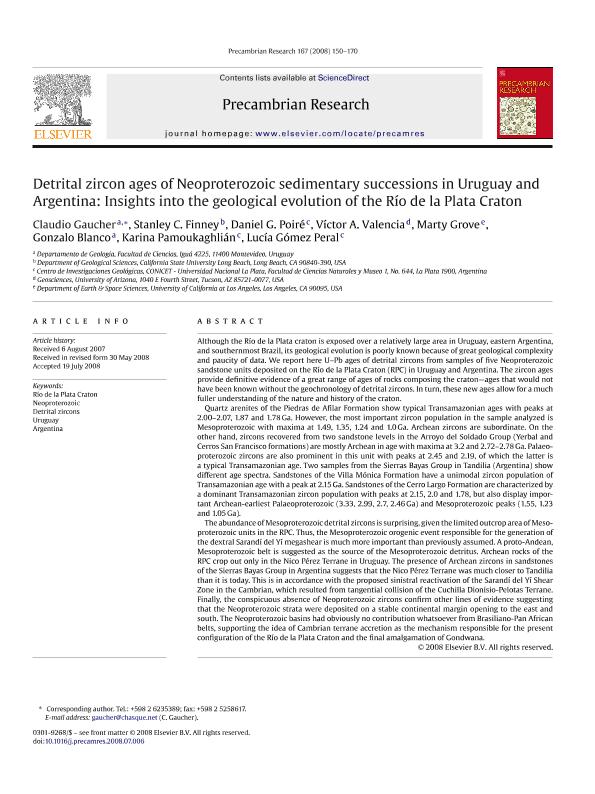Artículo
Detrital zircon ages of Neoproterozoic sedimentary successions in Uruguay and Argentina: Insights into the geological evolution of the Río de la Plata Craton
Gaucher, Claudio; Finney, Stanley C.; Poire, Daniel Gustavo ; Valencia, Víctor A.; Grove, Marty; Blanco, Gonzalo; Pamoukaghlian, Karina; Gómez Peral, Lucia
; Valencia, Víctor A.; Grove, Marty; Blanco, Gonzalo; Pamoukaghlian, Karina; Gómez Peral, Lucia
 ; Valencia, Víctor A.; Grove, Marty; Blanco, Gonzalo; Pamoukaghlian, Karina; Gómez Peral, Lucia
; Valencia, Víctor A.; Grove, Marty; Blanco, Gonzalo; Pamoukaghlian, Karina; Gómez Peral, Lucia
Fecha de publicación:
11/2008
Editorial:
Elsevier Science
Revista:
Precambrian Research
ISSN:
0301-9268
Idioma:
Inglés
Tipo de recurso:
Artículo publicado
Clasificación temática:
Resumen
Although the Río de la Plata craton is exposed over a relatively large area in Uruguay, eastern Argentina, and southernmost Brazil, its geological evolution is poorly known because of great geological complexity and paucity of data. We report here U-Pb ages of detrital zircons from samples of five Neoproterozoic sandstone units deposited on the Río de la Plata Craton (RPC) in Uruguay and Argentina. The zircon ages provide definitive evidence of a great range of ages of rocks composing the craton-ages that would not have been known without the geochronology of detrital zircons. In turn, these new ages allow for a much fuller understanding of the nature and history of the craton. Quartz arenites of the Piedras de Afilar Formation show typical Transamazonian ages with peaks at 2.00-2.07, 1.87 and 1.78 Ga. However, the most important zircon population in the sample analyzed is Mesoproterozoic with maxima at 1.49, 1.35, 1.24 and 1.0 Ga. Archean zircons are subordinate. On the other hand, zircons recovered from two sandstone levels in the Arroyo del Soldado Group (Yerbal and Cerros San Francisco formations) are mostly Archean in age with maxima at 3.2 and 2.72-2.78 Ga. Palaeoproterozoic zircons are also prominent in this unit with peaks at 2.45 and 2.19, of which the latter is a typical Transamazonian age. Two samples from the Sierras Bayas Group in Tandilia (Argentina) show different age spectra. Sandstones of the Villa Mónica Formation have a unimodal zircon population of Transamazonian age with a peak at 2.15 Ga. Sandstones of the Cerro Largo Formation are characterized by a dominant Transamazonian zircon population with peaks at 2.15, 2.0 and 1.78, but also display important Archean-earliest Palaeoproterozoic (3.33, 2.99, 2.7, 2.46 Ga) and Mesoproterozoic peaks (1.55, 1.23 and 1.05 Ga). The abundance of Mesoproterozoic detrital zircons is surprising, given the limited outcrop area of Mesoproterozoic units in the RPC. Thus, the Mesoproterozoic orogenic event responsible for the generation of the dextral Sarandí del Yí megashear is much more important than previously assumed. A proto-Andean, Mesoproterozoic belt is suggested as the source of the Mesoproterozoic detritus. Archean rocks of the RPC crop out only in the Nico Pérez Terrane in Uruguay. The presence of Archean zircons in sandstones of the Sierras Bayas Group in Argentina suggests that the Nico Pérez Terrane was much closer to Tandilia than it is today. This is in accordance with the proposed sinistral reactivation of the Sarandí del Yí Shear Zone in the Cambrian, which resulted from tangential collision of the Cuchilla Dionisio-Pelotas Terrane. Finally, the conspicuous absence of Neoproterozoic zircons confirm other lines of evidence suggesting that the Neoproterozoic strata were deposited on a stable continental margin opening to the east and south. The Neoproterozoic basins had obviously no contribution whatsoever from Brasiliano-Pan African belts, supporting the idea of Cambrian terrane accretion as the mechanism responsible for the present configuration of the Río de la Plata Craton and the final amalgamation of Gondwana. © 2008 Elsevier B.V.
Archivos asociados
Licencia
Identificadores
Colecciones
Articulos(CIG)
Articulos de CENTRO DE INVEST.GEOLOGICAS (I)
Articulos de CENTRO DE INVEST.GEOLOGICAS (I)
Citación
Gaucher, Claudio; Finney, Stanley C.; Poire, Daniel Gustavo; Valencia, Víctor A.; Grove, Marty; et al.; Detrital zircon ages of Neoproterozoic sedimentary successions in Uruguay and Argentina: Insights into the geological evolution of the Río de la Plata Craton; Elsevier Science; Precambrian Research; 167; 1-2; 11-2008; 150-170
Compartir
Altmétricas



